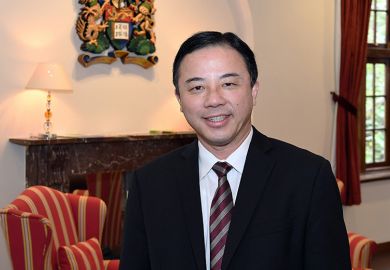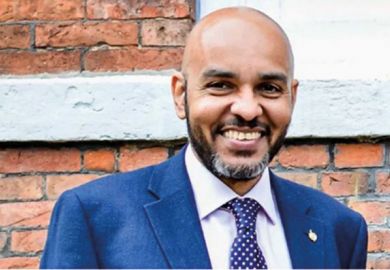Source: Femke de Jong
Like HBOS, London Met had a governing board that provided an insufficient challenge to the executive and did not ensure that it received a proper flow of information
What can higher education learn from the collapse of HBOS? A recent report by the Parliamentary Commission on Banking Standards, An Accident Waiting to Happen, contains some critical messages for university governance. To recap the basic facts, HBOS was created in 2001 from a merger of the Halifax and the Bank of Scotland and it promptly embarked on a programme of expansion that concentrated on residential and commercial property. At its peak in 2007, the bank had a market value of £40 billion. Its growth in assets far outstripped the level of its customer deposits, however, and with the fall in property values it had to be rescued by a takeover by Lloyds TSB, which required an injection of £20.5 billion from the government (that is, from the taxpayer). The parliamentary commission described HBOS’ performance as “a colossal failure of senior management and of the board”.
So how did the board carry out its responsibilities? In the 1990s, a series of reports - the Cadbury, the Hampel and the Higgs reports - were all concerned to improve corporate governance by increasing the role of non-executive directors on company boards. Their reforms were brought to a conclusion by the drafting of a UK Corporate Governance Code, which included provisions on audit, risk and internal controls, under the auspices of the Financial Reporting Council. The Committee of University Chairs followed suit by creating a Governance Code of Practice, thus emphasising the parallel that the committee apparently saw between university governing bodies and company boards.
HBOS operated a federal management structure. The different divisions - corporate, retail, insurance and investment, international and so on - were run separately, but their chief executives formed an executive committee under the group chief executive, which advised the board. The board’s membership included key executives drawn from this committee and the non-executive members. Sir Ronald Garrick (coincidentally a member of the Dearing Committee and chairman of its Scottish subcommittee), a non- executive director and deputy chairman of the board, described the HBOS board to the parliamentary commission as: “…by far and away the best board I ever sat on. My recollection of the culture and characteristics of the board was one of openness, transparency, high intellect, integrity, good working relations between the chairman and chief executive, and a suitable diversity of backgrounds, mix of experience and expertise to maximise effectiveness.” When the board assessed its own performance, it concluded in its minutes that it “made effective but supportive challenges, as necessary, [but] would not seek to second guess executive management’s formulation of strategy”.
A more critical assessment from a former group risk director was that any challenges came from the executive, not the non-executive, members and that he could not recall any occasion when the board significantly changed a policy advanced by the executive committee.
In its report of 4 April, the parliamentary commission concludes that the board “represents a model of self-delusion, of the triumph of process over purpose”, that it had abrogated its responsibility for strategy and that its membership had insufficient banking expertise and lacked the necessary experience or insight and skills to identify many of the core risks. It was driven by the executive and failed to exercise a critical role in respect to the expansion strategy or to the risks involved.
Many of the same features were apparent at London Metropolitan University between 2002 and 2009, a period marked by governance, management and operational failures described by Sir Alan Langlands, chief executive of the Higher Education Funding Council for England, as “unprecedented in higher education in this country in recent years”. The parallels are striking. Like HBOS, London Met was the product of a merger (in 2002). Like HBOS, it had a governing board that provided an insufficient challenge to the executive and did not ensure that it received a proper flow of information. Nor did it exercise adequate supervisory control over a senior management team that was described by the Melville Review, which was commissioned by the university to investigate what had gone wrong, as “a highly centralised and dictatorial executive led by the vice- chancellor, which was incapable of listening to what was going on in the university, discouraged or ignored criticism and made decisions without consultation”. At the heart of London Met’s financial difficulties lay a “clawback” of £36.5 million demanded by Hefce in respect to funding for students who had failed to complete their academic programme within a funding year. On London Met’s definition, the overall non-completion rate was 3 per cent whereas the funding council saw it as 30 per cent. As at HBOS, the board lacked the expertise to understand the funding implications of the high dropout rates, and neither internal audit nor the university officers kept the audit committee or the board informed of the risks that were being run.

Hefce was too respectful of institutional autonomy and was not guided sufficiently by what should have been gut feeling about the level of internal mismanagement
But there are wider messages for universities. In 1997, all six of the Dearing Committee’s recommendations on governance concerned codes of conduct, membership and the need for effectiveness reviews. The same points were echoed in the 2003 Lambert report’s recommendations on governance. The CUC’s own 2010 report What Is an Effective and High Performing Governing Body in UK Higher Education? lists 15 factors that enable or are an outcome of effective governance, but only one refers to challenging the executive. A minor industry has grown up in reviewing the effectiveness of governing boards, but all too much of it focuses on process rather than on the effectiveness of the business itself - one of the very things the parliamentary commission criticised the HBOS board for doing. No one would deny the importance of due process in governance, but as both the HBOS and London Met cases demonstrate, the more important qualities are expertise in the business of the organisation and a willingness to challenge the executive.
Here the constitutions of post-1992 universities (in legal terms, higher education corporations) make them more vulnerable because they deny academic boards a policy role in strategy, which is restricted to chief executives and governing boards. The members of governing bodies at post- 1992 institutions are all by definition lay non-executives except the chief executive; and there is not the same level of academic representation as there is at pre-1992 universities, where up to a third of board members may come from academic boards. Moreover, lay members at the post-92s are drawn primarily from the commercial world and the professions and, like the HBOS board, lack expertise in the business of the organisation that they are appointed to control: at London Met a retired dean, pro vice-chancellor or registrar would instantly have recognised the risks embedded in high dropout rates and would have warned of the financial implications. With a minimum of academic representation, the boards of higher education corporations are at the mercy of their executive team, which controls the information that comes to the board.
Governance that is shared with an active and well-informed senate, as happens in pre-1992 universities, offers a much more secure policy structure and a greater opportunity to identify risk. A good example might be the decision of the University of Warwick’s senate in 2003 to vote down its vice-chancellor’s plan to open a campus in Singapore, which had been approved by its governing body. The decision was vindicated when the University of New South Wales pulled out of a parallel venture in Singapore on financial grounds after 18 months. Such action would have been impossible under a higher education corporation constitution. An alternative to rewriting the constitutions of such institutions would be for their boards to extend their expertise by recruiting as members some retired senior university academics and administrators to help them understand the complex environment in which higher education operates and to assess the way the executive responds to it.
In one further respect the commission also offers an instructive message for the sector. It is very critical of the Financial Services Authority, whose “regulatory approach encouraged a focus on box-ticking which detracted from consideration of the fundamental issues”. Similar criticisms can be made of Hefce’s role vis-à-vis London Met. Hefce met only 50 per cent of the original bid for financial support for the merger that brought London Met into being - a bid that was in any case too low because the two universities involved lacked the confidence to bid higher. The Melville Review shows that Hefce’s own audit teams failed to interrogate London Met on its interpretation of eligibility for funding, and crucial meetings were left unminuted, allowing London Met to harbour the belief (always later denied by Hefce officers) that some kind of arrangement might be made to refund the “clawback” through some other mechanism. Hefce was too respectful of institutional autonomy and was not guided sufficiently by what should have been gut feeling about the level of internal mismanagement. It acted firmly at the end and threatened to withdraw funding altogether, but its failure to act earlier served only to increase the figure that had to be clawed back.
This is important for the funding council’s future role as regulator for the sector. Without legislation to follow up the 2011 White Paper, the funding council is potentially powerless to use financial sanctions to curb inappropriate behaviour by an institution or to act to protect student interests because, under the new funding system, it will have lost its funding role. The case of London Met and of other universities (such as Gloucestershire and Cumbria) that have experienced problems involving ineffective governance demonstrate weaknesses in post-1992 institutions’ governance structure - weaknesses that may be concealing other “accidents waiting to happen”.
Register to continue
Why register?
- Registration is free and only takes a moment
- Once registered, you can read 3 articles a month
- Sign up for our newsletter
Subscribe
Or subscribe for unlimited access to:
- Unlimited access to news, views, insights & reviews
- Digital editions
- Digital access to THE’s university and college rankings analysis
Already registered or a current subscriber? Login




